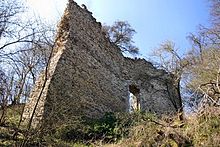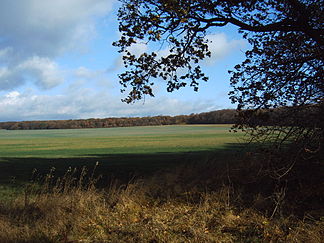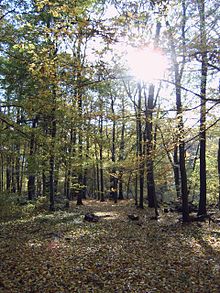Hook
| Hook | |
|---|---|
|
Location of the hook in the northeastern Harz foreland |
|
|
South-western edge of the hook |
|
| Highest peak | Elevation of the Domburg ( 244.5 m above sea level ) |
| location | at Heteborn ; District of Harz and Salzlandkreis , Saxony-Anhalt ( Germany ) |
| part of | Central German black earth region |
| Coordinates | 51 ° 53 ′ N , 11 ° 19 ′ E |
| rock | Lower Muschelkalk |

The Hakel at Heteborn is one to 244.5 m above sea level. NHN high ridge of the northeastern Harz foreland in the Harz and Salzland district in Saxony-Anhalt .
geography
location
The Hakel is about 18 km east-southeast of Halberstadt and 16 km (as the crow flies ) north-west of Aschersleben . It extends in the area of the localities of Heteborn , as the core of the ridge, as well as Cochstedt , Hakeborn , Hedersleben and Schadeleben . Southwest his country falls to the Selke back from that then only slightly to the west, then each far north and east of there in the flowing of Höhenzugs Bode flows, and south to at Schadeleben and Friedrichsaue lying Concordiasee . Cochstedt Airport is located east-southeast .
Natural allocation
The Hakel heard in the natural environment feature unit group Mitteldeutsches black soil area (no. 50) in the main unit Northeast harzvorland (502) and in the sub unit Hakel (502.1) for natural space Hakelschwelle (502.10).
Surveys
The elevations in the hook include - sorted by height in meters (m) above sea level (NHN):
- Elevation of the Domburg (244.5 m), southeast of Heteborn
- nameless hilltop? (236.8 m), east of Heteborn
- Philipps Galgenberg (224.2 m), north-northwest of Schadeleben
- Lausehügel (207.5 m), north of Schadeleben
- Markberg (203.1 m), northeast of Hedersleben
- Speckberg (194.2 m), west of Heteborn
geology
The Hakel is a mountain range with little relief, the geological structure of which consists essentially of rocks from the Lower Muschelkalk . It is a broad saddle . The soils consist of thin loess and various brown earths .
Domburg
On the highest elevation of the Hakel is the ruin Domburg , once a Germanic cult site and later a medieval castle. The remains of the wall and the moat have been preserved. The hook is mentioned in 997 as Hacul in an Otton deed.
Protected areas
In the wooded Hakel lies the two-part nature reserve (NSG) Hakel ( CDDA -Nr. 163489; designated 1995; 13.23 km² in size; according to other information 13.66 km²), which consists of the forest areas Großer Hakel and Kleiner Hakel . It covers the entire area with the Hakel fauna-flora-habitat area south of Kroppenstedt (FFH no. 4134-301; 13.23 km²). The landscape protection area (LSG) Hakel (1939; 13.66 km²) is also located on the ridge . In addition, parts of the Hakel bird sanctuary (VSG no. 4134-401; 64.41 km²), which is part of the EU SPA areas, are located on the ridge . In approximately 33.69 ha large total reserve human intervention omitted completely. A 37.07 km² area in the vicinity is also largely excluded from use and management.
Flora and fauna
Light oak and hornbeam forests , in which many linden trees are interspersed, form the main vegetation. Rare thermophilic species such as service tree ( Sorbus torminalis ) or service tree ( Sorbus domestica ) occur. Oak and linden trees grow in places on slightly acidic soil. Only very small areas are covered with herbaceous vegetation, coniferous forests and grassland.
The Hakel is of national importance as a breeding area for over 70 bird species, including the Lesser Spotted Eagle ( Aquila pomarina ), a very endangered species. The Red Kite ( Milvus milvus ) and the Black Kite ( Milvus migrans ) reached the Hakel in the 1970s and 1980s very high population density, but the population has continuously decreased in recent years. Goshawks ( Accipiter gentilis ), sparrowhawks ( Accipiter nisus ) and honey buzzard ( Pernis apivorus ) breed on birds of prey in the nature reserve . In 1995 and 1996 the booted eagle ( Aquila pennata ) also brooded in the Hakel, which is otherwise not represented as a breeding bird in Germany. There are also a few rarer species such as the sparrowhawk ( Sylvia nisoria ), the common woodpecker ( Dryobates medius ), the woodcock ( Scolopax rusticola ) and the miniature flycatcher ( Ficedula parva ).
The hook is also the habitat of many mammals and various, sometimes rare, insect species. This forest area is also known for its abundance of mushrooms: over 600 different mushrooms have been found.
Individual evidence
- ↑ a b c d e Map services of the Federal Agency for Nature Conservation ( information )
- ↑ Gerald Patzelt: Geological Guides Collection, Volume 96, Northern Harz Foreland (Subherzyn), eastern part , Brothers Bornträger, Berlin 2003, ISBN 3-443-15079-9
- ↑ a b c d Hakel Nature Reserve ( Memento of the original from June 10, 2008 in the Internet Archive ) Info: The archive link was inserted automatically and has not yet been checked. Please check the original and archive link according to the instructions and then remove this notice. , at the state administration office of Saxony-Anhalt, on lvwa-natur.sachsen-anhalt.de





